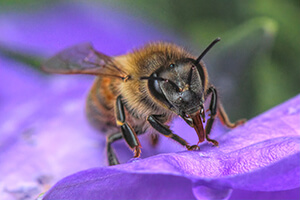
Maybe this was all a big mistake. Each time I research bee tongues, I find a cursory review, perhaps two or three paragraphs making the structures sound plain and spartan. So I set out to learn more, an unfortunate choice. I should have known there was a reason everyone avoids the subject.
If you look in a mirror and examine your tongue, it looks simple enough. It’s front and center, all of a piece, and just long enough to fit.
The same is not true for bee tongues. On the contrary, they are intensely complicated, having multiple moving parts with names no one can remember. And the parts have subparts, as do the subparts. But bee tongues are vitally important, especially to bees, so it’s worth thinking about them occasionally.
As I read more and more, I decided to cover less and less in this article. You could make a lifetime study of bee tongues if you wanted to — but I trust you don’t — so this will be a summary.
The long and short of it
No doubt, you’ve heard of long-tongued bees and short-tongued bees. They forage on different plants and collect nectar using slightly different methods. But it turns out that their tongues are structurally different, and the actual length of the tongue has little to do with anything.
Worldwide, there are seven families of bees. Of those seven, just two are long-tongued: the Apidae and the Megachilidae. Since honey bees are in the Apidae, they are by definition long-tongued bees.
The long-tongued bees have a stunning range of tongue lengths, from relatively short, like honey bees, to inexplicably long, like orchid bees. The specialist bees, those that forage on particular plants or plant families, generally have tongues designed to fit their favorite plants. Generalist bees, those that forage on a wide range of plants and plant families, have all-purpose tongues that work in many situations.
The five-part proboscis
In long-tongued bees, the proboscis — the thing we usually call the tongue — is supple and hairy. But more to the point, it’s made of multiple parts, only one of which is the true tongue. The other parts offer structural support — a scaffolding of sorts to protect the real thing.
The true tongue, a flexible central tube, is called the glossa or the salivary canal. The glossa has some internal support of its own, a type of flexible rod running end to end. It also has a groove the runs the entire length.
At the tip of the glossa is a small structure called the labellum. This appendage is crazy hairy on the top side and shaped like a tiny bowl. The bee uses the labellum to lap up refreshment and the hairs keep the food from sloshing out of the bowl.1
Four other parts, two labial palpi and two galeae, come together to form a sturdy sheath around the glossa. The labial palpi and galeae fit together with Lego-like precision, forming a watertight cylinder. This outer tube, known as the food canal, securely protects the inner salivary tube. So, yes, the proboscis is made from a one-part tube inside a four-part tube — at least in the long-tongued bees.2
Help from the mandibles
To keep the proboscis from swaying from side to side as the bee eats, the mandibles extend forward from each side of the bee’s face and brace the entire structure.
Mandibles serve all kinds of functions in a bee’s life, but stabilizing the proboscis is not one we normally consider. Despite that, stabilization is the one function that’s common to nearly all bees. The other uses vary, depending on the species. Females use mandibles for chewing, cutting nesting materials, collecting mud, shaping wax, or removing debris. Males may use them for fighting or mating.3
Regardless of their use, bee mandibles are powerful. They are activated by a pair of oversize muscles that pull them in and out, taking up much of the space inside a bee’s head.
All the subparts
Most references stop here, but this simple explanation doesn’t quite cover the complexity of all the mechanical connections. What I’ve missed in prior discussions is the relationship between the maxilla and the labrum to the proboscis.
In bees, the maxillae (one on each side of the mouth) and the labrum (an upper lip of sorts) fuse to form — deep breath — a labiomaxillary complex.4 You didn’t need to know that, right?
But it’s cool. The labium is in the center and includes both the labial palpi and the glossa. It also includes a bunch of fiddly little parts leading to the glossa called the submentum, mentum, and prementum. The maxillae are on either side of the central labium and include the cardines (stabilizing rods), stipes, maxillary palpi, and the galeae. In all, the labiomaxillary complex comprises 17 moveable parts.
You don’t need to memorize the details, but it’s good to recognize that a bee tongue is not a simple thing. In summary, the proboscis is derived from parts of the maxillae and parts of the labrum, all fused into one extremely intricate structure designed for collecting liquids such as honey, nectar, and water.
The sucking pump
At the base of the glossa is a series of specialized muscles surrounding an empty cavity. This structure, called the cibarium or sucking pump, siphons food from the tip of the glossa through the length of the food canal. Just as pumping your smoker sucks air into the firebox, pumping the cibarial chamber sucks liquid into the bee’s mouth.
Liquid food or water begins its journey through the narrow food canal by capillary action. As it begins to move upward, it’s aided by ….


